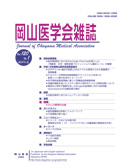

Journal of Okayama Medical Association
Published by Okayama Medical Association<Availability>
Full-text articles are available 3 years after publication.
Permalink : http://escholarship.lib.okayama-u.ac.jp/19309
末梢血白血球培養に関する基礎的並に臨床的研究 第1篇 方法論並に健康人末梢血白血球培養の細胞増生に就て
十川 保
岡山大学医学部平木内科教室
発行日
1959-03-15
抄録
With the purpose to maintain the cell function in a good condition for the peripheral-leucocyte culture the author compared various methods of tissue culture, and then investigated the tissue growth of peripheral leucocytes of normal persons in culture. The results are as follows: 1. For the preservation of blood to be cultured the use of the container whose inner surface coated with silicon is the best way to maintain the cell function as compared with the conventional method. 2. The expansion of growth area surrounding the original peripheral leucocyte mass in normal persons ceases after 6 hours' culture, and with the lapse of time the central zone of the growth area becomes less dense due to the emigration of wandering cells towards the peripheral zone, creating a space and thus this presents a corona-like appearance specific to this type of growth. 3. As for cells wandering out, the majority of them are neutrophils at the early stage of culture,and gradually numbers of eosinophils and lymphocytes increase; and after 12 hours' culture monocytes make their appearance. 4. As regards the distribution of cells in the growth area after 24 hours' culture, the peripheral zone is occupied mainly by neutrophils, and eosinopbils are scattered there, too; and the intermediate zone is chiefly occupied by lymphocytes and a few monocytes, but the central part is occupied by many monocytes.
ISSN
0030-1558
NCID
AN00032489
